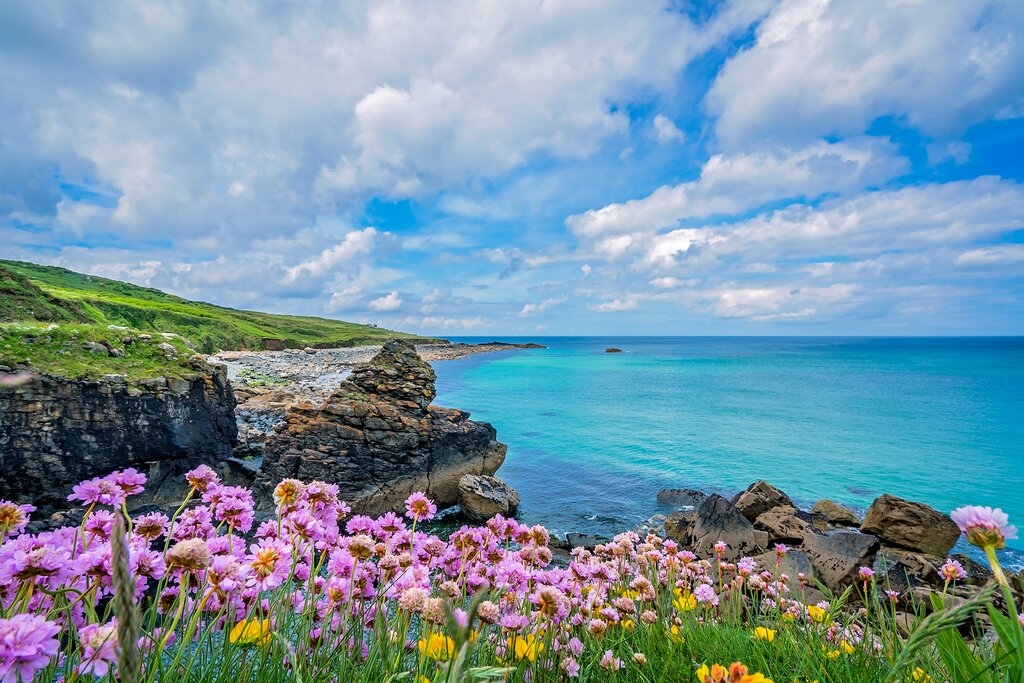
July is prime summertime in England, with the best weather of the year and long daylight hours to enjoy activities like hiking, swimming, and surfing. You can also kick back on a leisurely road trip through the stunning countryside and stop at historical attractions. Of course, England’s cities beckon in July with music festivals and an enormous Pride parade in London.
## England in July: A Comprehensive Travel Guide
July in England is a truly special time, a month when the country bursts into life with vibrant energy and a palpable sense of celebration. The weather is at its most inviting, the days are long and filled with sunshine, and the opportunities for exploration and adventure are seemingly endless. This guide will delve into the specifics of traveling to England in July, covering everything from the weather and crowds to the best places to visit and the exciting events taking place throughout the month.
**The Delightful Weather of July**
July is, without a doubt, a magnificent month for weather in England. After the sometimes unpredictable spring, July offers a welcome period of warmth and sunshine. Temperatures reach their peak during this time, creating ideal conditions for outdoor activities and sightseeing. Not only are temperatures at their warmest of the year, but visitors can also benefit from more than 15 hours of daylight throughout the month, providing ample time to explore the country’s many attractions.
While the overall weather pattern is consistent across England, there are subtle regional differences that are worth noting. The nation’s capital, **London**, typically experiences some of the highest temperatures in the country. Daily highs in **London** average around 73°F (23°C), while lows average around 59°F (15°C). These comfortable temperatures make it a perfect time to wander through the city’s iconic streets and parks.
Further north, closer to Scotland, cities such as **York** and **Manchester** tend to be slightly cooler. This is due to their geographical location and exposure to different air currents. Similarly, coastal towns, while often sunny, benefit from refreshing sea breezes that can temper the warmth and provide a welcome respite from the midday sun.
The summer months, including July, are generally drier than the fall and winter seasons. July typically sees an average of 2.5 inches (6 cm) of rain. However, it’s important to remember that England is known for its changeable weather. A sunny morning can quickly give way to a brief shower, so it’s always wise to be prepared. As the saying goes, “There’s no such thing as bad weather, only bad clothing.” Embrace England’s fickle weather as part of the experience, and make sure to pack a versatile wardrobe. Summery clothes are essential, but light layers are equally important for handling an evening chill or a sudden rain shower. A light jacket or sweater, along with a compact umbrella or waterproof coat, will ensure you’re ready for anything the English weather throws your way.
**Navigating Crowds and Costs**
July marks the official high season for tourism in England. Along with August, it’s one of the most popular months to visit, as families take advantage of school holidays and travelers from around the world flock to experience the country’s many attractions. The increased demand during this period inevitably leads to higher prices for flights, accommodations, car rentals, and various activities.
To mitigate the impact of the crowds and costs, consider traveling during the midweek rather than on weekends. Weekends tend to be particularly busy, especially in popular tourist destinations. By opting for a weekday visit, you may find more elbow room and potentially lower prices. Additionally, consider traveling during the first half of July, before the UK schools begin their six-week summer holiday. This can help you avoid the peak travel period and potentially secure better deals.
If you have your heart set on a particular hotel, event, or experience, such as Wimbledon, it’s essential to book well in advance. Popular accommodations and attractions often fill up quickly during the high season, so early planning is crucial to avoid disappointment. Booking flights and accommodations several months in advance can often result in significant savings.
**Exploring England: Where to Go**
**London’s** Heathrow Airport serves as the primary gateway for most international visitors arriving in and departing from England. Before venturing further afield, consider dedicating some time to explore the sprawling capital city. **London** offers a wealth of iconic landmarks, world-class museums, and vibrant neighborhoods, all waiting to be discovered on foot or by bike.
Once you’re ready to escape the hustle and bustle of the city, **London’s** excellent transportation system provides easy access to a variety of nearby destinations. Day trips to places like **Windsor Castle**, with its rich history and stunning architecture, or the world-renowned university towns of **Oxford** and **Cambridge**, offering a glimpse into academic life and beautiful surroundings, are all easily accessible from **London**.
For those seeking to explore further afield, longer train journeys provide access to major English cities such as **Leeds**, **Birmingham**, **Liverpool**, **Manchester**, and **York**. Each of these cities boasts its own unique character and attractions, both within the city limits and in the surrounding outskirts. **Leeds** offers a vibrant cultural scene and bustling shopping districts, while **Birmingham** is known for its industrial heritage and diverse culinary offerings. **Liverpool**, the birthplace of the Beatles, is a must-visit for music lovers, and **Manchester** offers a blend of history, culture, and modern innovation. **York**, with its stunning cathedral and medieval walls, provides a glimpse into England’s rich past.
Summer is also an ideal time to embark on a road trip, giving you the freedom to explore the English countryside at your own pace. If you have limited time, consider heading south from **London** towards the coast via the **Surrey Hills**, an Area of Outstanding Natural Beauty (AONB) characterized by rolling hills and picturesque landscapes. This scenic route will lead you to **Brighton’s** famous beach and amusement pier, a classic seaside destination with a vibrant atmosphere.
From **Brighton**, you can work your way east to the iconic white chalk cliffs of **Dover**, a symbol of England’s coastal beauty, or west to the UNESCO-listed **Jurassic Coast**, a stunning stretch of coastline renowned for its dramatic cliffs and fossil-rich beaches.
For a less beach-focused road trip, consider traveling through the six counties that make up the **Cotswolds**. This region is famed for its charming thatched villages and quaint market towns, such as **Banbury** and **Broughton**, offering a glimpse into traditional English rural life.
To escape the crowds, venture further north to the **Lake District**, a region offering a touch of Scotland with its rugged mountains and pristine lakes. The **Lake District** provides opportunities for swimming, boating, hiking, and simply soaking in the stunning natural scenery.
Meanwhile, the **Cornish coast** will be bustling with activity during July, but there are plenty of options to suit every taste, from hidden surf villages to larger resort towns like **St. Ives**, with its own **Tate** modern art museum.
For a truly unique experience, consider taking a ferry (or flying) to the **Isles of Scilly**, a nearby archipelago offering a slower pace of life with turquoise bays, sandy beaches, and ample opportunities for summer relaxation.
**What to Do in England During July**
England is wide open and brimming with activities during July. Locals know how to make the most of their short summer season. Join them and stay outdoors as much as possible. You can find kayaking, surfing, horseback riding, and fishing activities.
Then there are the simple pleasures of visiting parks, gardens, and areas of architectural significance, perhaps with a guided walking tour. **Blenheim Palace**, the birthplace of Winston Churchill, offers sprawling manicured grounds. You can easily spend half a day exploring the grounds. In **Bath**, take a private walking tour of the preserved Roman bath complex surrounded by 18th-century Georgian architecture. Learn more about writers like Jane Austen. Another hot spot for literature is **Stratford-upon-Avon**, the birthplace of William Shakespeare. Visit his former home and school.
Hikers want to head for England’s many trails offering degrees of difficulty and length. Consider a section of the **Cotswold Way**, a 102-mile footpath through the region. Or head for the south coast for trails offering views of the English Channel and the Atlantic Ocean. Some offer Bronze Age earthworks and Celtic landmarks. When you’re ready to rest your feet, tuck into fresh seafood at local pubs and restaurants.
**Events in July**
July in England is packed with a diverse range of events and festivals, catering to a wide variety of interests. Here are a few highlights:
* **Tramlines Festival**, **Sheffield**: Named after Sheffield’s tram system, this festival attracts thousands of people to see England’s best indie rock bands. They perform in various venues throughout the city.
* **WOMAD Festival, Malmesbury**: World music fans will want to check out this international festival near **Bath** that celebrates music, dance, and the arts.
* **Cambridge Folk Festival, Cambridge**: Beginning at the end of July, this event celebrates music of various genres. It’s one of the oldest folk festivals in the world.
* **Love Supreme, Sussex**: This annual three-day jazz festival takes place on the first weekend of July. It offers a broad mix of jazz genres including blues, funk, and soul.
* **Early Music Festival**, **York**: Appropriately named, this music festival is devoted to classical music from the 18th century and earlier.
* **Pride**, **nationwide**: Pride celebrations take place across the country in July. The largest parade happens in **London**, usually early in the month.
* **Wimbledon**, **London**: This famous tennis grand slam attracts the best players in the world. The two-week event starts in late June and trickles into early July. Tickets are available to the public.
* **Swan Upping**, **Windsor**: Attend this ceremonial counting of the swan population on the upper River Thames near **Windsor**. The event dates back to the 12th century.
* **Henley Royal Regatta**, **Henley-on-Thames**: This rowing event on the River Thames attracts thousands of onlookers over several days.
By carefully considering the weather, crowds, costs, and the many attractions and events on offer, you can plan an unforgettable trip to England in July. Whether you’re exploring the bustling streets of **London**, hiking through the scenic **Lake District**, or soaking up the sun on the **Cornish coast**, England in July promises an experience filled with memories.
B-751

